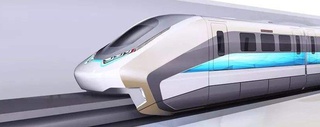Transatlantic Maglev
The idea of a tunnel linking New York and London first appeared in a novel by Victorian science fiction writer, Jules Verne in 1895. But the possibility of it ever appearing was remote due to the mind-blowing difficulty of such a project.

Rendering by Pete Stoppel
What: Transatlantic underwater tunnel and Maglev supersonic train
Where: Between New York and London
Cost: $12 Trillion
For example, it would take an estimated 300 years to drill the required distance of 3100 miles underneath the floor of the Atlantic Ocean - not to mention the obstacles posed by underwater mountain ranges and the frequent earthquakes.
An alternative could be a tunnel that is submerged and sits on the ocean floor like the famous San Francisco BART but this idea has its own impossibilities. For instance, the pressure at that bottom of the Atlantic is 500 times that of the surface – enough to crush the strongest steel and concrete structures.

Rendering by Ricardo Broch
The most viable option would be to have a tunnel that floats deep enough to avoid interfering with shipping lanes but shallow enough to be safe from pressure. The tunnel would be secured by a series of cables anchored to the bottom of the sea. The cables would be adjustable and give just enough slack to allow the tunnel to absorb the impacts of savage ocean currents and tidal flows. Even so, the interference of animals such as whales colliding with the structure cannot be estimated.

Diesel trains are too slow and would emit noxious fumes that couldn’t be dispersed. Electric trains like the current Japanese Bullet trains don’t go fast enough to offer a worthwhile alternative to flying. Maglev trains would be the obvious choice but can they go faster than a plane? Maglev trains could, in theory, reach speeds of up to 5000mph - nearly ten times faster than a commercial jumbo jet. How?
Well, two things stop a train from reaching very high speeds: friction and air-resistance. Maglev trains float, about one inch, from the track which means there is no friction to resist the train’s motion.

Now, say you could remove the air-resistance by having the trains operate in a vacuum tube. There would be no air-resistance at all and no friction either. This means that the trains could accelerate faster and faster reaching speeds of around 5000 mph.
A tunnel offers the perfect opportunity to have a maglev train operate in a vacuum and a project as huge at a transatlantic tunnel would almost certainly want to implement this groundbreaking technology. Traveling at 5000 mph from New York, you would reach London in 54 minutes.
However, the engineering challenge of constructing a vacuum tunnel across the Atlantic Ocean is staggering and most experts believe it is impossible. For instance it would take enough concrete and steel to build a 10 storey building to construct just one section of the tunnel. And you would need about 50,000 separate sections.

What’s more, is each section would have to be held perfectly in place and linked up to an impressive GPS system to make sure they remained in exact alignment. To remove all the air and create a vacuum, you would need 100 jet engines, working 24 hours per day for two weeks just to suck all the air out.
But these are mere irritancies compared to the massive problem of finding the one billion tones of steel needed to build the tunnel – that’s as much as all the world’s steel mills produce in a year.
It would take 100 years to build such a tunnel at a cost of $12 trillion which is about 15% of the GDP of the entire world. Other tunnels such as the Channel Tunnel which links England and France and the Japanese Seikan Tunnel struggle to make a profit and cost 0.003% of that.
So it is not surprising that no-one in the world is seriously considering the project which remains in the realms of science fiction.





